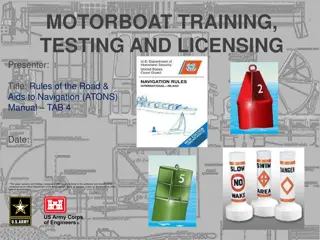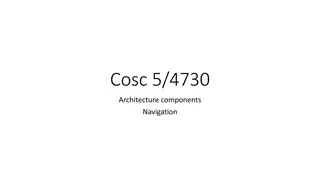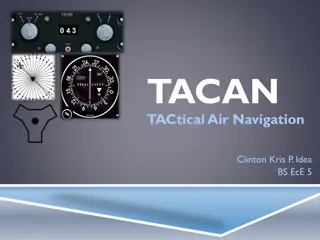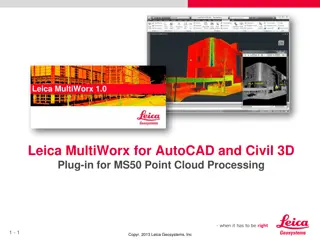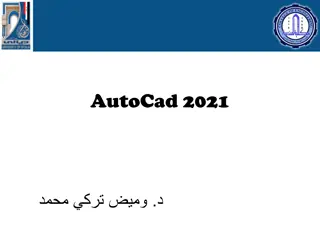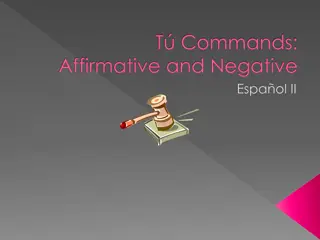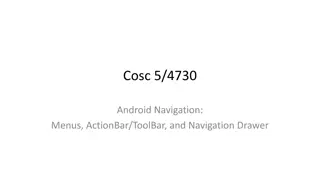Mastering AutoCAD Basics: Commands, Navigation, and Tools
Explore the fundamentals of AutoCAD with a focus on commands, navigation using mouse or digitizing tablet, and essential tools like Pan and Zoom. Learn how to efficiently type commands, utilize pointing devices, and shift views in this comprehensive guide.
Download Presentation

Please find below an Image/Link to download the presentation.
The content on the website is provided AS IS for your information and personal use only. It may not be sold, licensed, or shared on other websites without obtaining consent from the author. Download presentation by click this link. If you encounter any issues during the download, it is possible that the publisher has removed the file from their server.
E N D
Presentation Transcript
Eshan College of Engineering Department of Mechanical Engineering Presented by Mr. Rajan Khare Assistant Professor
LaunchingAutoCad 1. Start 2. 3D and CAD 3. AutoCad
Typing Commands Typing a Command All AutoCAD commands can be typed in at the command line. Many commands also haveone or two letter aliases that can also be typed as shortcuts to the commands. 1. Type the desired command at the command prompt. Command : LINE or 2. Type the command s alias. Command: L 3. Press ENTER/Space to end. 4. Type an option at the command prompt. TIP: Many AutoCAD commands require you to press ENTER to complete the command. You know you areno longer in an AutoCAD command when you see a blank commandline. Reissuing the Last Command The last used AutoCAD command can be re-entered by one of the following three methods of ENTER. The ENTER key on the keyboard will always act as ENTER, the SPACEBAR and RIGHT MOUSE will act as enter most of the time (exceptions include placingTEXT). 1.Press the ENTER key on thekeyboard or 2.Press the Space bar on thekeyboard. or 3. Click the right mouse button.
Pointing Device(Mouse) AutoCAD uses either a mouse or digitizing tablet to select objects in a drawing. Left Mouse Button Used to pick or select objects 1. Click the left mouse button to select an object area in the drawing. 2. Press ESC twice to deselect an object (or to cancel a command). Right Mouse Button Used to enter a command, repeat last command, or access shortcut menus. 1. Click the right mouse button. TIPS: SHIFT + the right mouse button brings up the object snap menus. Various screen locations for the mouse brings up different menus. menus.
5.2 PAN Shifts the location of a view. 1. View, Pan. Choose or 2. the Pan icon. Click or PAN from the command prompt. 3. Type Command: PAN or P TIPS: - While in the PAN command, click with the right mouse button to see the following menu. - Panning can also be done by using the window scroll bars
5.1 ZOOM Increases or decreases the apparent size of objects in the current viewport 1. View, Zoom. Choose or 2. Click a Zoom icon. or 3. Type ZOOM at the command prompt. Command: Zoom or Z 4. Type One of the following zoom options: The following are basic zoom options: All Places entire drawing (all visible layers) on display at once. Forces a regeneration. Displays current drawing content as large as possible. Restores previous view. Previous Window Extents Designates rectangular area to be drawn as large as possible. Magnification relative to ZOOM All display Magnification relative to current display (1X) Specifies center point and new display height. Number NumberX Center Dynamic Permits you to pan a box representing the viewing screen around the entire generated portion of the drawing and enlarge or shrink it. TIPS: -While in the ZOOM command, click with the right mouse button to see the menu to the right.
2.2 Creating a New Drawing NEW Command Creates a new drawing file. 1. File, New. Choose or 2. Press CTRL + N or 3. Click the New icon. or NEW at the Command prompt. 4. Type Command: NEW Choose One of the options for creating a new drawing. 5. Click The OK button. 6. Save 7. the drawing as another name. TIP: New drawings can also be created from Template Files.
1.11 Undo and Redo Reverses the last action. 1. Choose Edit, Undo. or 2. Click the Undo icon. or 3. 4. Press CTRL +Z. Type U at the command prompt to undo the last command. Command: U Redo Reverses the effects of a single UNDO or U command. Choose Edit, Redo. 1. or Click the Redo icon. 2. or Type REDO at the command prompt to redo the last undo command. 3. Command: REDO TIPS: -UNDO has no effect on some commands and system variables, including those that open, close, or save a window or a drawing, display information, change the graphics display, regenerate the drawing, or export the drawing in a different format. -REDO must immediately follow the U or UNDO command.
2.1 Open Existing Drawings File, OPEN. 1. Choose or 2. CTRL + O. Press or 3. the OPEN icon. Click or 4. OPEN at the command prompt. Type Command: OPEN 5. ENTER the desired directory to find the drawing to open. Press 6. Double Click 7. the drawing name to open. Click 8. The OK button. Click TIP :-Preview shows a bitmap image of the drawing selected. This image is the view that was last saved in the drawing. It will not show a preview of drawings saved before R13 AutoCAD.
Quick Save The QSAVE command is equivalent to clicking Save on the File menu. If the drawing is named, AutoCAD saves the drawing using the file format specified on the Open and Save tab of the Options dialog box and does not request a file name. If the drawing is unnamed, AutoCAD displays the Save Drawing As dialog box (see SAVEAS) and saves the drawing with the file name and format you specify. 1. CTRL + S. Press or 2. the Save icon. Click or 3. QSAVE at the command prompt, Type Command:QSAVE TIPS: Drawings can be saved as different versions of AutoCAD (e.g. R13, R14, R 2000, etc.) AutoSave settings under Tools, Options
7.1 Running Object Snaps An object snap mode specifies a snap point at an exact location on an object. OSNAP specifies running object snap modes, which remain active until you turn them off. Tools, Drafting Settings... 1. Choose or DDOSNAP at the command prompt 2. Type Command: DDOSNAP or 3. Click OSNAP on the Status Bar. Right Click the Object SnapTAB. an object snap to turn ON/OFF from the dialog box. 4. Choose 5.
AutoCAD 2D Tutorial UNITS Command 8.5 1. Choose Format,Units... or DDUNITS at the commandprompt. 2. Type Command: DDUNITS or UN a units and anglesetting. Choose 3. Choose a precisionsetting. 4. - 58 -
3.1 Line Command Creates single straight line segments Draw, Line. 1. Choose or 2. Click the Line icon. or LINE from the command prompt 3. Type Command: LINE or L Press 4. ENTER Pick 5. From point: (point) Specify next point or [Close/Undo]:(point) Pick 6. Specify next point or [Close/Undo]:(point) Pick 7. Press 8. ENTER to end line sequence or U to undo the last segment 9. Type To point: U (undo) or 10. Type C to create a closed polygon To point : C (close) TIPS: You can continue the previous line or arc by responding to the From point: prompt with a space or ENTER. Choose the right mouse button for the line pop-up menu to appear while in the line command
AutoCAD 2D Tutorial Pline Command15.1 Apolyline is a connected sequence of line segments created as a single object. You can create straight line segments, arc segments, or a combination of the two. 1. Draw,Polyline. Choose or Pick 2. the Plineicon. PLINEatthecommandprompt Type 3. Command : PLINE orPL Apointonthedrawing tostartthepolyline 4. Pick Frompoint:(select) 5. Type One ofthe following options Arc/Close/Halfwidth/Length/Undo/Width/<endpointof line>: or 6. Pick A point to continue drawing Arc/Close/Halfwidth/Length/Undo/Width/<endpointof line>:(pickpoint) Polyline as onesegment - 128 -
3.4 Orthogonal Lines Controls lines from being drawn at various angles to straight lines. When the snap grid is rotated, ortho mode rotates accordingly. 1. Function Key F8. Press or ORTHO from the Status Bar. 2. Double Click or CTRL + L. 3. Press Linedrawn with ORTHO OFF Linedrawn with ORTHOON
AutoCAD 2D Tutorial Rectangle16.2 Draw, Rectangle. 1. Choose or 2. Click the Rectangleicon. or 3. Type Rectang at the command prompt Command: RECTANGChamfer/Elevation/Fillet/Thickness/Width/ <First corner>: Pick 4. first corner. Pick 5. other corner or type coordinates (i.e. @4,2). - 137 -
3.6 Circles Circle Command Circle, CenterRadius 1. Draw, Circle. Choose or 2. Click the Circle icon. or 3. Type CIRCLE at the command prompt. Command: CIRCLE Circle, CenterDiameter 4. Type One of the following options: 3P/2P/TTR/<<centerpoint>>: or Pick 5. A center point. Type 6. A radius or diameter. or A radius or diameter 7. Pick Circle, Tangent, Tangent Radius Diameter/<<radius>>: TIPS: - To create circles that are the same size, press ENTER when asked for the circle radius. Circle, Tangent, Tangent,Tangent - When selecting a circle with a pickbox, be sure to select the circumference of the circle.
7. Arc Command Draw,Arc. 1. Choose or the Arc icon. 2. Click or ARC at the command prompt 3. Type Command: ARC 4. Draw One of the arcs. TIPS: -Except for 3 point arcs, arcs are drawn in a COUNTERCLOCKWISE direction. - While in the arc command, press the right mouse button to select the following options for arcs: Arc Examples 3 point arc Start ,center, chord length start, center, end Start, end, radius Start , center, includedangle Start, end, direction
AutoCAD 2D Tutorial Spline 16.3 The SPLINE command creates a particular type of spline known as a nonuniform rational B-spline (NURBS) curve. A NURBS curve produces a smooth curve between controlpoints 1. Draw,Spline. Choose or the Splineicon. or 2. Click 3. SPLINE atthe command prompt Type Command: SPLINE 4. Astartpointfor thespline Pick Object/<Enter firstpoint>:(pickpoint) 5. Pointsuntilyouaredonedrawingsplines Pick Enterpoint:(pickpoints) 6. Enterorclosetocomplete thespline Press 7. Starting tangentpointforthespline Pick Enterstart tangent(pickpoint) 8. Ending tangentpointforthespline Pick Enter end tangent: (pickpoint) - 138 -
AutoCAD 2D Tutorial Editing Polylines15.2 1. Modify, Polyline. Choose or 2. thePediticonfromtheModifyIItoolbar. Pick 3. PEDITat thecommandprompt Type Command: PEDIT 4. Pickapolylinetoedit Pick SelectPolyline:(pick) Oneofthefollowingoptions:Close/Join/ Width/Edit vertex/FitCurve/Spline/Curve/ 5. Type Decurve/Undo/eXit PEDIToptions: Close Closes open polylinesegments Connects polylines, lines, and arcs to existing polylines. Join Width Changesthewidthforallpolylinesegments. Fitcurve Creates curved arc segments around pline vertices atthe direction youspecify. Spline Curve Createsa curve throughcontrol pointsonapolyline. Decurve Straightens curved segments. Displays the following Edit VertexOptions: Edit Vertex Polyline widthchange SplinedPolyline - 130 -
AutoCAD 2D Tutorial Move Command 10.1 1. Modify, Move. Choose or 2. Click the Moveicon. or MOVE at the commandprompt 3. Type Command: MOVE or M Objects tomove 4. Pick Select objects:(select) A point to movefrom 5. Pick Base point or displacement: (pickpoint) A point to move to 6. Pick Second point of displacement: (pickpoint) Circle before move Circle after move TIP: To move an object a specified distance, type adistance at the second point of displacement prompt:@1<0 - 74 -
AutoCAD 2D Tutorial Copy Command 10.2 1. Modify, Copy. Choose or 2. Click the Copyicon. or COPY at the commandprompt. 3. Type Command: COPY or CP 4. Objects to copy. Select objects:(select) Pick A point to movefrom. 5. Pick Base point or displacement/Multiple: (pick point). A point to copy to. 6. Pick Second point of displacement: (pickpoint) or 7. Type A point to copy to. Second point of displacement: @1<0 Duplicate objectscopied Multiple objectscopied TIP: To copy many objects in the same copy command, type M for Multiple at the Base point or displacement/Multiple option. - 75 -
AutoCAD 2D Tutorial Offset Command 10.4 OffsetDistance To offset a specifieddistance: 1. Modify, Offset. Choose or 2. the Offseticon. Choose or 3. OFFSET at the commandprompt. Type Command: OFFSET or O 4. The distance to offset. Type Offset distance or <Through point>:(number) 5. The object to offset. Select object to offset: (selectobject) Pick 6. A side to offset objectto. Pick Side to offset: (pickside) 7. Another object tooffset Pick Select object to offset: (pickside) or 8. Enter to end thecommand. Press Offsetting objects by specifying adistance - 77 -
AutoCAD 2D Tutorial Explode Command15.4 1. Modify,Explode. Choose or Pick Type 2. 3. theExplodeicon. EXPLODE atthe command prompt. Command: EXPLODE or 4. Pick Theobjecttoexplode. Selectobjects:(pick) Polylinebefore explode Polyline (line) afterexplode - 133 -
AutoCAD 2D Tutorial EXTEND 10.5 1. Choose Modify,Extend. or 2. Click the Extendicon. or EXTEND at the commandprompt 3. Type Command:EXTEND Select boundaryedge(s)... 4. Pick The BOUNDARY edge to extendto Select objects:(select) 5. Press ENTER to accept the boundaryedge Select objects: (pressenter) 6. Pick The objects to extend <Select object to extend> / Project / Edge / Undo: Select an object, enter an option, or press enter : (select) 7. Press ENTER when you are done choosing objects LinesExtended to an Arc (Arc is boundary edge) TIP: - Use the object selection option FENCE to choose multiple objects - 79 -
AutoCAD 2D Tutorial Stretch 13.2 1. Choose Modify,Stretch. or Click Type 2. 3. theStretchicon. STRETCHatthecommandprompt. Command : STRETCH Select objectstostretchbywindow... CtochooseCROSSING window 4. Type Select objects:C Pick Pick 5. Afirstcornertostretch. Firstcorner:(point) Theopposite cornertowindowtheobjects to stretch. 6. Othercorner:(point) Press 7. ENTERtoacceptobjectstostretch. Abasepoint tostretchfromBasepoint: Pick 8. (point) - 114-
AutoCAD 2D Tutorial Apoint tostretch toNewpoint: (point) 9. Pick or 10. Type Adistancetostretch. Newpoint: @1<0 TIP: TheStretchcommand must useaCROSSING windowor aCROSSING POLYGONwindow. - 115-
AutoCAD 2D Tutorial TRIM 10.6 The TRIM command allows you to trim objects in a drawing so they end precisely at a cutting edge defined by one or more other objects in the drawing. 1. Modify, Trim. Choose or 2. Click the Trimicon. TRIM at the commandprompt 3. Type Command: TRIM Select cutting edge(s)... The CUTTING edgeto extendto 4. Pick Select objects:(select) ENTER to accept the cuttingedge 5. Press Select objects: (press enter) Objects to trim 6. Pick <Select object to trim> / Project / Edge / Undo: Select an object, enter an option, or pressenter ENTER when you are done choosing objects 7. Press Select object to trim/Undo: (press enter) Lines Trimmed to an Arc (Arc is cutting edge) TIP: Hold the SHIFT key to interactively extend instead oftrim. - 80 -
AutoCAD 2D Tutorial Break13.1 1. Choose Modify, Break. or the Breakicon. 2. Click or Type 3. BREAKat the commandprompt. Command: BREAK Pick 4. Object tobreak. Selectobject:(selectoneobject) A second breakpoint. 5. Pick Entersecondpoint:(point) or 6. F tochooseadifferentbreakpoint Type Entersecondpoint(orFforfirstpoint):(F) - 112 -
AutoCAD 2D Tutorial MIRROR 10.7 1. Modify, Mirror. Choose or 2. the Mirror icon. Click or 3. MIRROR at the commandprompt. Type Command: MIRROR 4. Objects to mirror. Pick Selectobjects:(select) 5. First point of mirror line:(point) Pick 6. Second point: (point) Pick Yes to delete the original objects and No to keepthem. 7. Type Delete old objects? Y orN MirrorLine - 82 -
AutoCAD 2D Tutorial ROTATE 10.9 1. Choose Modify, Rotate. or 2. Click the Modifyicon. or ROTATE at the commandprompt 3. Type Command : ROTATE 4. Pick Objects to rotate: Selectobjects:(select) A pivot point to rotatearound 5. Pick Base point: (point) 6. Type A rotation angle<Rotationangle>/Reference: (number) or 7. Pick A rotation angle<Rotation angle>/Reference:(point) - 84 -
AutoCAD 2D Tutorial SCALE 10.10 1. Choose Modify, Scale. or 2. Click the Scaleicon. or SCALE at the commandprompt 3. Type Command: SCALE Select objects: (selectobjects) 4. Pick A pivot point to scale about Base point: (point) 5. Type A rotation angle<Scalefactor>/Reference:(number) or 6. Pick A scale factor<Scalefactor>/Reference: (point) Scale factor/Reference:(points) - 86 -
AutoCAD 2D Tutorial Text Command 11.1 Text Creates a single-line textobject TEXT at the commandprompt 1. Type Command: TEXT or the Single Line Text icon from the Text Toolbar. 2. Pick A startpoint 3. Pick Justify/Style/<Start Point>: (point) or 4. Type J to change the justification or S to change the text style. A text height Height <default>: (type value or pick twopoints) 5. Type A rotationangle 6. Type Rotation angle <default>: (angle orpoint) A textstring 7. Type Text: (type text string) enter to exit the Text:prompt. 8. Press DTEXT (Dynamic Text) Creates a single-line text object, showing the text dynamically on the screen as it isentered. 1. Draw, Text, Single LineText. Choose or DTEXT at the commandprompt 2. Type Command : DTEXT 3. Follow the steps 3-8 fromabove. - 89 -
AutoCAD 2D Tutorial Introduction to Layers and Layer Dialog Box12.1 1. Format, Layer. Choose or LAYER at the commandprompt. 2. Type Command: LAYER (orLA) or the layers icon from the Layer Controlbox on the object propertiestoolbar. 3. Pick AutoCAD 2005 Layer Properties - 101-
AutoCAD 2D Tutorial Layer Options 12.2 ? Make Set Lists layers, with states, colors and linetypes. Creates a new layer and makes itcurrent. Sets currentlayer. Creates new layers . New Turns on specifiedlayers. ON Turns off specifiedlayers. OFF Assigns color to specified layers. Color Assigns linetype to specifiedlayers. Ltype Completely ignores layers during regeneration. Freeze Unfreezes specified layers Ltype. Thaw Makes a layer read only preventing entities from being edited but available visual reference and osnapfunctions. Lock Places a layer in read write mode and available for edits. Unlock Plot Turns a Layer On forPlotting NoPlot Turns a Layer Off forPlotting Controls the line weight for each layer LWeight TIP: Layers can be set using the command line prompts for layers. To use this, type LAYER or -LA at the command prompt Command: -LAYER orLA 1. Type One of the following layeroptions 2. Type ?/Make/Set/New/ON/OFF/Color/Ltype/Freeze/Thaw: - 102-
AutoCAD 2D Tutorial Layer Shortcuts 12.3 Changing the Layer of anObject Once on the object tochange. 1. Click the desired layer from the Layer Control Box dropdown. 2. Select AutoCAD will move the object to the new layer. Select layer Select object first - 103-
AutoCAD 2D Tutorial Color Command 12.6 1. Format, Color. Choose or DDCOLOR at the commandprompt. 2. Type Command: DDCOLOR orCOL or Color on the Object Properties toolbar and then select a color from the list or select Other to display the Select Color dialogbox. 3. Choose TIP: These settings ignore the current layer settings forcolor. By Layer If you enter bylayer, new objects assume the color of the layer upon which they aredrawn. By Block If you enter byblock, AutoCAD draws new objects in the default color or black, depending on your configuration) until they are grouped into a block. When the block is inserted in the drawing, the objects in the block inherit the current setting of the COLOR command. (white - 107-
AutoCAD 2D Tutorial Linetypes 12.7 Loading and ChangingLinetypes 1. Format, Linetype... Choose or DDLTYPE at the commandprompt. 2. Type Command:DDLTYPE or LT 3. Load... to see a list of availablelinetypes. Choose 4. the desired linetype toassign. Choose 5. OK. Click - 108-
AutoCAD 2D Tutorial Lineweights 12.8 Loading and ChangingLineweights 1. Format, Lineweight... Choose or LINEWEIGHT at the commandprompt. 2. Type Command: LINEWEIGHT orLWEIGHT or a lineweight to make current from theObject Properties menu. 4. Pick TIPS: - Lineweights can also be assigned tolayers. - The Display Lineweights feature can be turned on/off on the status bar to show or not show lineweights in the drawing, thus making regenerations faster. - Lineweights are displayed using a pixel width in proportion to the real- world unit value at which they plot. If you are using a high-resolution monitor, you can adjust the lineweight display scale to better display different lineweightwidths. - 109-
AutoCAD 2D Tutorial Object Properties 12.9 Modify, Properties. or 1. Choose the Propertiesicon. 2. Click or DDCHPROP or DDMODIFY at the commandprompt. 3. Type Command: DDCHPROP (CH) or DDMODIFY(MO) 4. Pick Objects whose properties you want to change Pick a window for DDCHPROP, single object for DDMODIFY. Select objects:(select) ENTER to accept objects. 5. Press Select objects: (pressenter) 6. Choose One of the following properties tochange. - 110-
OtherUseful Functions
AutoCAD 2D Tutorial BHATCH Command 17.1 1. Draw,Hatch... Choose or 2. Click theHatchicon. or BHATCHat thecommandprompt 3. Type Command: BHATCH - 152 -
AutoCAD 2D Tutorial Measuring Distances 8.2 1. Tools, Inquiry, Distance. Choose or 2. Click the Distance icon from the Inquiry Toolbar. or 3. Type DIST at the commandprompt Command: DIST 4. Pick The first point to measurefrom First point: pickpoint 5. Pick The second point to measure to Second point: pickpoint Distance Between CircleCenters TIP: Be sure to use Object Snaps with the MEASUREcommand. - 55 -
AutoCAD 2D Tutorial Linear Dimensions 26.1 1. Dimension,Linear. Choose or 2. Click the Linear Dimension command from thetoolbar. or DIM at the commandprompt. 3. Type Command:DIM Dim: HOR orVER - 223 -
AutoCAD 2D Tutorial Aligned Dimensions 26.2 1. Dimension,Aligned. Choose or the Aligned Dimensioncommand from the toolbar. 2. Click or DIM at the commandprompt. Command:DIM 3. Type Dim:ALIGNED - 224 -




